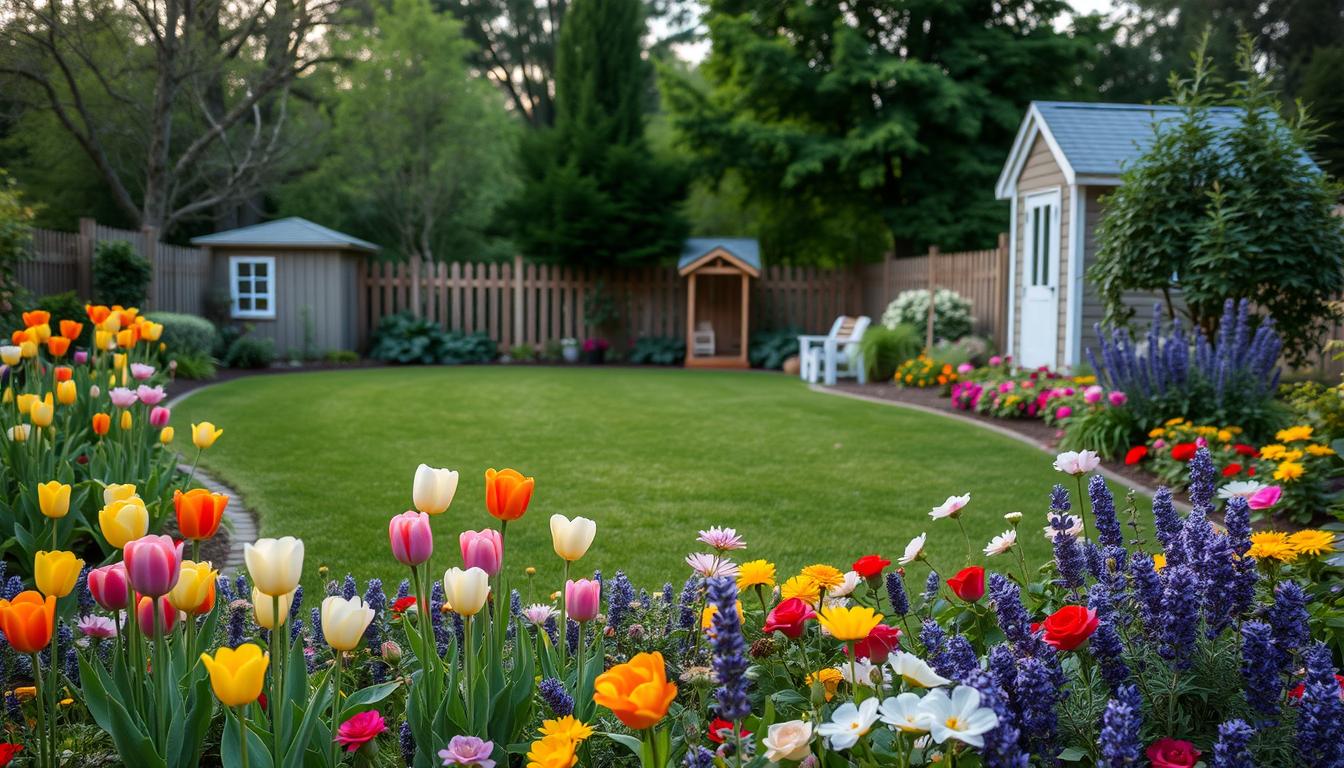Growing your own fresh vegetables and herbs can be incredibly rewarding. There’s nothing quite like harvesting produce straight from your yard. To make the most of your efforts, smart planning is essential.
Proper preparation ensures healthier plants and better yields. Factors like sunlight exposure, spacing, and bed configuration play a big role. These elements help your plants thrive and reduce common mistakes.
For beginners, raised beds and container gardening are excellent options. They simplify maintenance and make it easier to manage your space. These methods work well for small yards or larger areas.
Whether you’re a seasoned gardener or just starting, simple designs can transform your outdoor space. With a little planning, you can create a thriving vegetable garden that suits your needs.
Key Takeaways
- Growing fresh vegetables and herbs at home is rewarding and fulfilling.
- Smart planning leads to healthier plants and better harvests.
- Consider sunlight, spacing, and bed configuration for optimal growth.
- Raised beds and container gardening are beginner-friendly options.
- Simple designs work for yards of all sizes and skill levels.
Why a Basic Garden Layout is Essential for Beginners
Starting your first vegetable garden can feel overwhelming, but a simple plan makes it manageable. A well-organized design helps you avoid common pitfalls and ensures your plants thrive. For beginners, focusing on small, manageable plots is the best way to build confidence and achieve success.
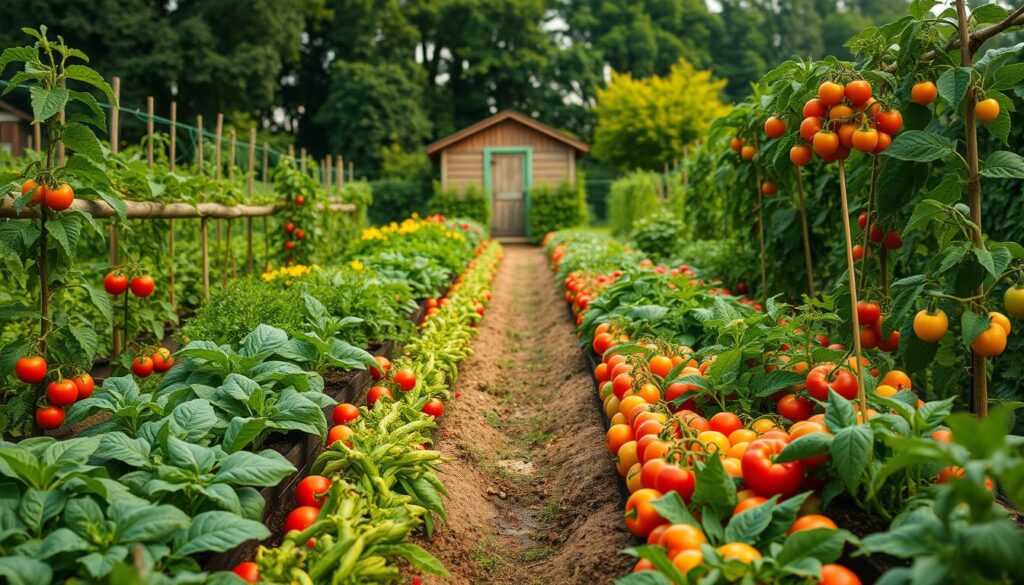
The Benefits of Starting Small
Large planting areas can lead to wasted resources and frustration. Instead, opt for smaller plots, like 4×4 feet, to focus your efforts. These compact spaces are easier to maintain and allow for better pest control.
For example, three raised beds can yield up to eight different vegetable varieties. This approach maximizes your space while keeping tasks manageable. Proper spacing and companion planting also reduce weeding and improve plant health.
How a Well-Planned Layout Saves Time and Effort
Strategic plant placement and efficient watering systems save time. Beds that are 3-4 feet wide prevent soil compaction, making it easier to care for your plants. This thoughtful design minimizes maintenance and boosts productivity.
By starting small and planning carefully, you’ll enjoy a thriving outdoor space without the stress. A structured approach ensures your gardening journey is both rewarding and enjoyable.
Choosing the Right Location for Your Garden
Finding the perfect spot for your plants is the first step to a thriving outdoor space. The right location ensures your plants get the sunlight, water, and nutrients they need to grow strong and healthy. A little planning can save you time and effort in the long run.
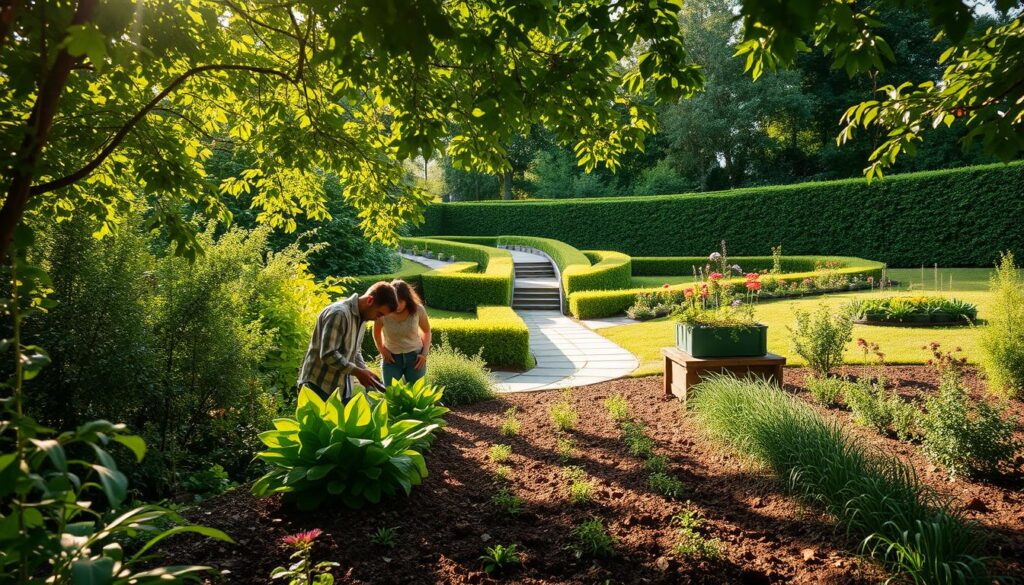
Assessing Sunlight and Shade
Most vegetables, like tomatoes and peppers, need 6-8 hours of sunlight daily. Use a smartphone app to track sun patterns in your space. This helps you identify the best spots for sun-loving plants.
If your area gets limited sunlight, don’t worry. Leafy greens and partial-shade vegetables like spinach and kale can thrive in shadier spots. Planning around sunlight ensures every plant gets what it needs.
Considering Proximity to Water Sources
Water is essential for healthy plants. Choose a location close to a water source to make irrigation easier. Measure your hose length to ensure it reaches every corner of your space.
Drip irrigation systems or soaker hoses can save water and time. Proper watering keeps your plants hydrated without overworking you.
Avoiding Competition from Trees and Shrubs
Be cautious of nearby trees and shrubs. For example, black walnut trees release toxins that can harm your plants. Roots from large trees can also compete for water and nutrients.
If your space is near trees, consider raised beds or containers. These solutions protect your plants and give them the resources they need to thrive.
Deciding What to Grow in Your Garden
Choosing the right plants for your space can make all the difference. Start by listing the vegetables and herbs you want to grow. Focus on produce that’s expensive to buy at the store, like tomatoes or fresh basil. This approach maximizes your savings and ensures a rewarding harvest.
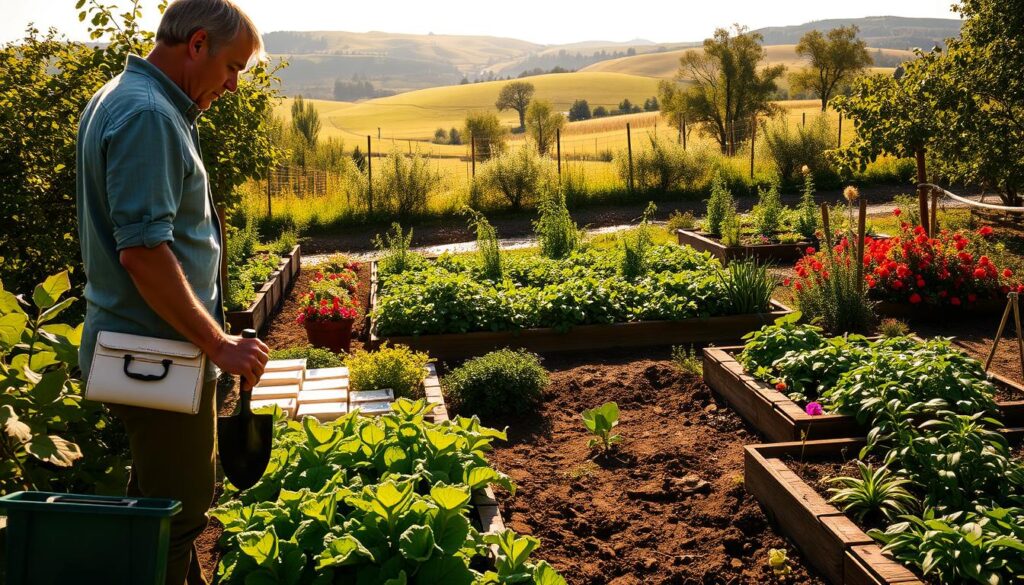
Listing Your Favorite Vegetables and Herbs
Create a “crop value” list to compare store prices with growing costs. For example, heirloom tomatoes and fresh herbs often cost more at the market but are easy to grow at home. Include pollinator favorites like basil and marigolds to attract beneficial insects. These additions boost your garden’s productivity and health.
Incorporating Space-Saving Techniques
If you’re working with a small space, consider vertical gardening. Use trellises for vining plants like cucumbers or compact hybrids like ‘Patio Princess’ tomatoes. These options save room and increase yields. Succession planting is another great strategy. Replace harvested crops with new ones to ensure a continuous supply of fresh produce.
- Prioritize expensive-to-buy produce for maximum savings.
- Use vertical gardening to maximize limited space.
- Include pollinator-friendly plants to enhance productivity.
Planning Your Garden Layout on Paper
Mapping out your outdoor space on paper is a smart way to start your gardening journey. A clear visual guide helps you organize your plants, beds, and walkways efficiently. This step ensures you make the most of your space and avoid common mistakes.
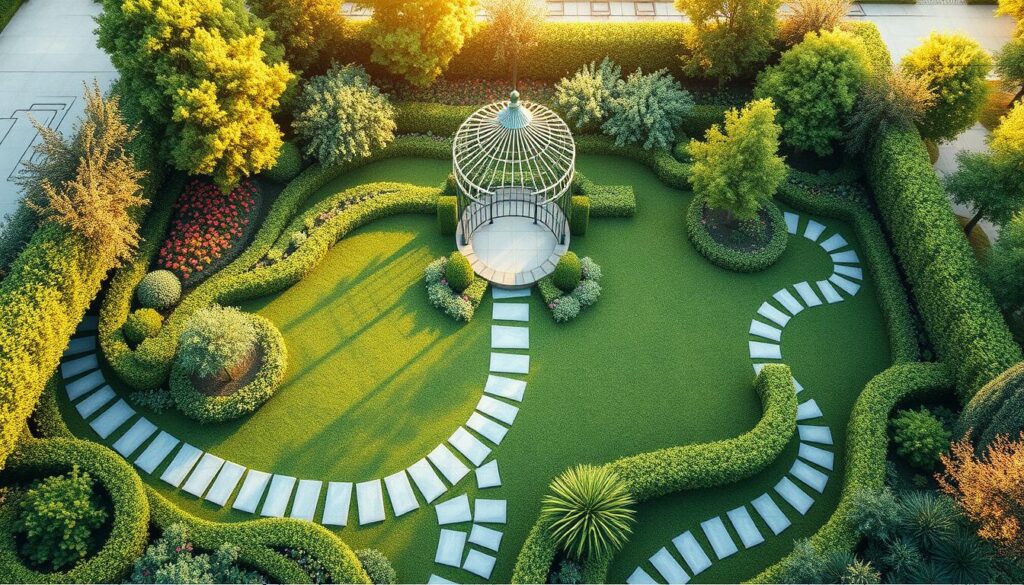
Using Graph Paper for Precision
Graph paper is a gardener’s best friend. Using a 1-foot-to-1-box ratio, you can create an accurate representation of your area. This method helps you plan bed widths of 3-4 feet, which are ideal for easy access and maintenance.
Grid-based templates work for all sizes, from small plots to larger yards. Label each section with plant names and dimensions to keep your plans organized. This approach ensures every inch of your ground is used effectively.
Sketching Beds and Containers
Start by drawing your beds and containers to scale. Include walkways of at least 2 feet for comfortable movement. Consider mature plant spacing to avoid overcrowding as your plants grow.
For example, tomatoes need 2-3 feet between plants, while lettuce can be spaced closer. This planning prevents sun-blocking placements and ensures healthy growth. A sample sketch with key dimensions can serve as a helpful reference.
- Use scaling techniques for accurate bed representations.
- Plan walkways to ensure easy access to all plants.
- Account for mature plant spacing to avoid overcrowding.
- Double-check sun exposure to prevent shaded areas.
Creating a Basic Garden Layout with Raised Beds
Raised beds are a game-changer for efficient and organized planting. They provide better soil control, improved drainage, and easier access to your plants. Whether you’re a beginner or an experienced gardener, raised beds can simplify your outdoor projects.
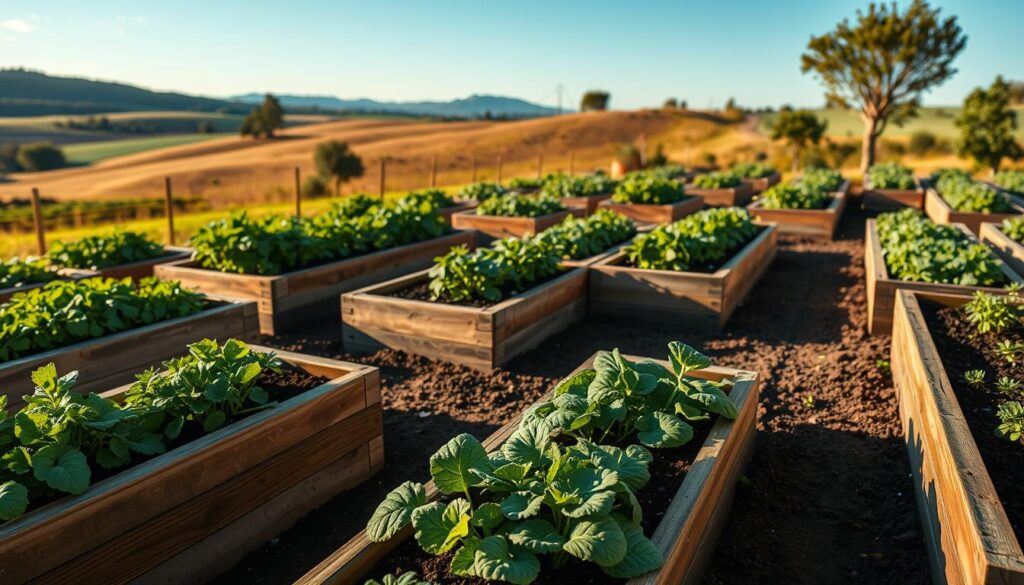
Advantages of Raised Beds
Raised beds offer numerous benefits. They prevent soil compaction, which promotes healthier root systems. You can also customize the soil mix to suit specific plants, ensuring optimal growth.
Another advantage is pest control. Elevated beds make it harder for pests to reach your plants. Additionally, they reduce the need for bending, making gardening more comfortable.
“Raised beds are a practical solution for maximizing space and improving plant health.”
Designing Raised Beds for Optimal Space
When designing raised beds, consider materials and dimensions. Cedar and composite materials are popular choices due to their durability and resistance to rot. A standard size is 4×8 feet, which provides ample space for planting.
| Material | Longevity | Cost |
|---|---|---|
| Cedar | 10-15 years | Moderate |
| Composite | 20+ years | Higher |
For sloped areas, tiered designs work well. They create multiple planting levels, maximizing your space. Ensure each bed has proper drainage, especially in wet climates. Adding gravel or perforated pipes can help.
Root vegetables like carrots need deeper soil, while greens like lettuce thrive in shallower layers. Adapting the Square Foot Gardening method can also optimize your raised beds. This technique divides the bed into sections, allowing for efficient planting and higher yields.
- Use rot-resistant materials like cedar or composite.
- Incorporate tiered designs for sloped areas.
- Ensure proper drainage for wet climates.
- Adjust soil depth based on plant needs.
- Apply Square Foot Gardening for space efficiency.
Maximizing Space with Vertical Gardening
Vertical gardening is a smart way to make the most of limited space. By growing upward, you can transform small areas into lush, productive zones. This method is perfect for urban settings or anyone looking to grow more in less room.
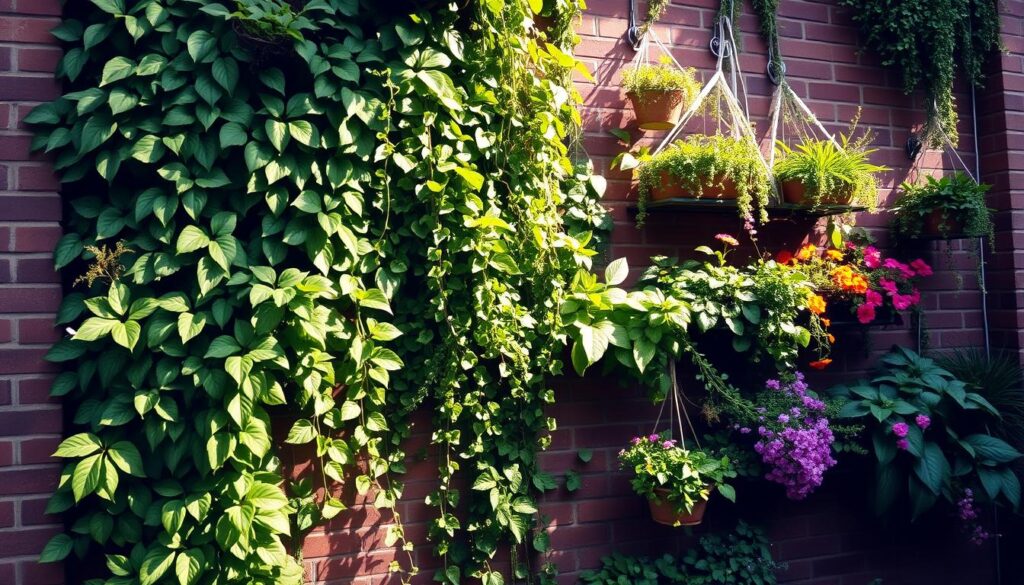
Using Trellises for Vining Plants
Trellises provide excellent support for vining plants like cucumbers, beans, and peas. Cattle panels are durable and easy to install, while bamboo teepees offer a natural, rustic look. Both options help maximize vertical space and keep your plants healthy.
Growing Vegetables in Containers
Containers are versatile and ideal for growing vegetables like cherry tomatoes, dwarf eggplants, and ‘Spacemaster’ cucumbers. Hanging baskets work well for cherry tomatoes, adding a decorative touch to your setup. Choose lightweight containers for balcony gardening to stay within weight limits.
Vertical layering is another great technique. Pair tall crops like corn with shade-tolerant greens to make the most of your space. For efficient watering, consider a DIY drip irrigation system. This setup ensures your plants stay hydrated without wasting water.
- Compare trellis types: cattle panels vs. bamboo teepees.
- List best container vegetables: dwarf eggplants, ‘Spacemaster’ cucumbers.
- Demonstrate vertical layering: tall corn with shade-tolerant greens.
- Include weight limits for balcony gardening safety.
- Share DIY drip irrigation system for vertical setups.
Incorporating Companion Planting
Companion planting is a natural way to boost your garden’s health and productivity. By pairing specific plants together, you can improve growth, deter pests, and maximize space. This method has been used for centuries and remains a favorite among gardeners today.
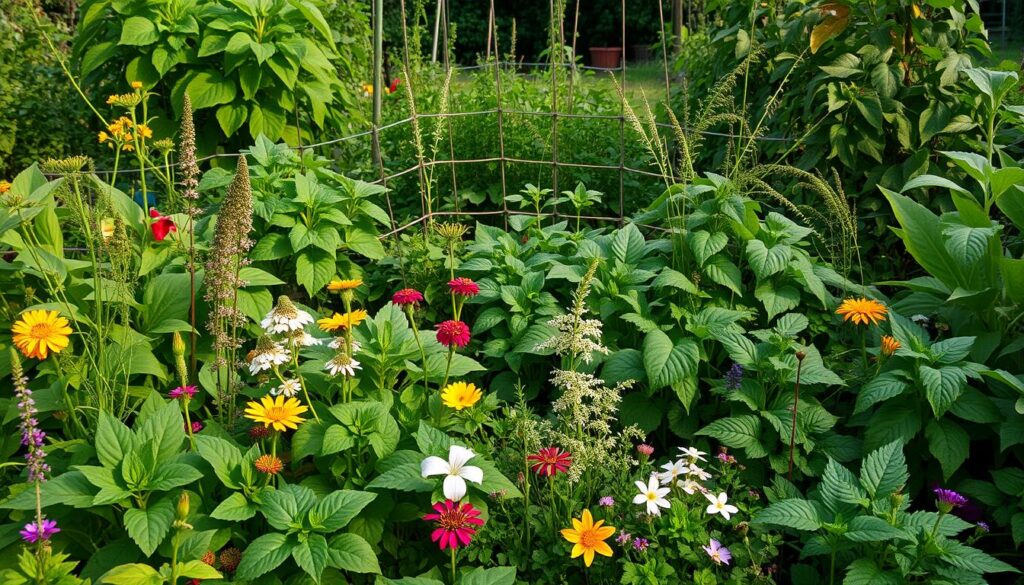
Benefits of Companion Planting
Companion planting offers numerous advantages. It enhances soil fertility, as some plants, like beans, fix nitrogen in the soil. This benefits neighboring plants like corn and squash. Additionally, certain flowers and herbs repel pests, reducing the need for chemicals.
For example, marigolds deter nematodes, while basil protects tomatoes from aphids. Companion planting also maximizes space by pairing tall plants with low-growing ones. This creates a balanced ecosystem where plants support each other.
Examples of Compatible Plant Pairings
Some plants thrive when grown together. Tomatoes and onions are a classic pair, as onions repel pests that target tomatoes. Cucumbers and marigolds also work well, with marigolds deterring harmful insects.
The “Three Sisters” method combines beans, corn, and squash. Beans fix nitrogen, corn provides support, and squash shades the soil, reducing weeds. Avoid incompatible pairs like dill and carrots, as dill can stunt carrot growth.
- Beans, corn, and squash form a nitrogen-fixing triad.
- Tomatoes and onions repel pests naturally.
- Cucumbers and marigolds deter harmful insects.
- Basil protects tomatoes from aphids.
- Nasturtiums repel aphids and add color.
| Vegetable | Companion Plant | Benefit |
|---|---|---|
| Tomatoes | Basil | Repels aphids |
| Cucumbers | Marigolds | Deters nematodes |
| Beans | Corn | Provides support |
| Carrots | Onions | Repels carrot flies |
Designing for Sunlight and Shade
Understanding sunlight and shade is key to a thriving outdoor space. Plants rely on light for growth, and managing their exposure ensures healthier results. Whether you’re growing vegetables or flowers, balancing sun and shade is essential.

Positioning Plants Based on Light Needs
Different plants have unique light requirements. For example, tomatoes and peppers thrive in full sun, needing 6-8 hours daily. Use tools like suncalc.org to map sunlight patterns in your space. This helps you identify the best spots for sun-loving plants.
Reflective mulches can also optimize light exposure. They bounce sunlight onto plants, ensuring even growth. Mobile containers are another great solution for areas with shifting shadows. Simply move them to follow the sun throughout the day.
Choosing Shade-Tolerant Vegetables
Not all plants need full sun. Leafy greens like lettuce, spinach, and arugula grow well in partial shade. These low-light heroes are perfect for shadier spots in your garden. Mustard greens and kale are also excellent choices for areas with limited sunlight.
- Create a sun requirement chart for popular vegetables.
- Use suncalc.org for accurate sun mapping.
- Apply reflective mulches to enhance light exposure.
- Include shade-tolerant options like arugula and kale.
- Use mobile containers for flexible light management.
By understanding sunlight and shade, you can create a thriving space for all your plants. Proper light management ensures healthier growth and a more productive garden.
Ensuring Proper Spacing Between Plants
Proper spacing between plants is crucial for a thriving outdoor space. When plants have enough room, they grow healthier and produce better yields. Overcrowding can lead to competition for nutrients, water, and sunlight, which stunts growth and increases the risk of disease.
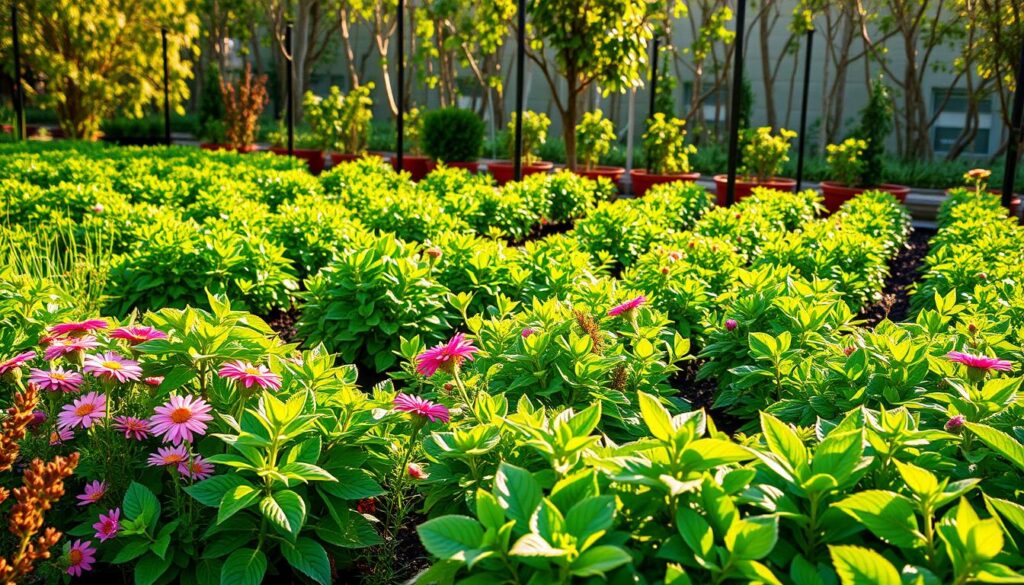
Understanding Plant Growth Requirements
Each plant has unique needs for space, sunlight, and nutrients. For example, tomatoes require 2-3 feet between plants to grow strong roots and avoid shading their neighbors. Leafy greens like lettuce can be spaced closer, as they don’t need as much room to thrive.
Root vegetables, such as carrots and radishes, need deeper soil and consistent spacing to develop properly. Overcrowding these plants can result in misshapen or stunted roots. Understanding these requirements helps you plan your garden effectively.
Avoiding Overcrowding
Overcrowding is a common mistake that can harm your plants. When plants are too close, they compete for resources, leading to weaker growth and lower yields. Proper spacing ensures each plant gets the nutrients and sunlight it needs.
For example, overcrowded tomatoes often develop fungal diseases due to poor air circulation. Giving them enough space reduces this risk and promotes healthier growth. Staggered planting is a great way to maximize space while avoiding overcrowding.
Spacing Cheat Sheet for Common Vegetables
| Vegetable | Spacing (inches) |
|---|---|
| Tomatoes | 24-36 |
| Lettuce | 6-12 |
| Carrots | 2-4 |
| Cucumbers | 36-48 |
Staggered Planting vs. Traditional Rows
Staggered planting allows you to fit more plants in a smaller area. Instead of planting in straight rows, arrange plants in a zigzag pattern. This method reduces competition for resources and improves air circulation.
Traditional rows are easier to manage but may waste space. For example, planting lettuce in straight rows leaves gaps that could be used for other crops. Staggered planting maximizes your garden’s potential.
Shoulder Season Intercropping Techniques
Intercropping involves planting fast-growing crops between slower-growing ones. For example, plant radishes between rows of tomatoes. The radishes will be ready to harvest before the tomatoes need the space.
This technique is especially useful during the shoulder seasons of spring and fall. It ensures your garden remains productive year-round.
Thinning Schedules for Root Vegetables
Root vegetables like carrots and beets often need thinning. This process removes excess plants to give the remaining ones enough space to grow. Thin seedlings when they are 2-3 inches tall, leaving 2-4 inches between plants.
Thinning ensures your vegetables develop properly and prevents overcrowding. It’s a simple step that can make a big difference in your harvest.
Damage Examples from Overcrowded Tomatoes
Overcrowded tomatoes often suffer from fungal diseases like blight. The lack of air circulation creates a humid environment that encourages fungal growth. Proper spacing reduces this risk and keeps your plants healthy.
Additionally, overcrowded tomatoes may produce smaller fruits due to competition for nutrients. Giving them enough space ensures they grow to their full potential.
Adding Pollinator Plants to Your Garden
Bringing pollinators into your outdoor space can transform it into a thriving ecosystem. Pollinator-friendly plants not only beautify your area but also boost its productivity. These additions attract beneficial insects, improve pollination, and enhance the health of your vegetables, fruit, and herbs.
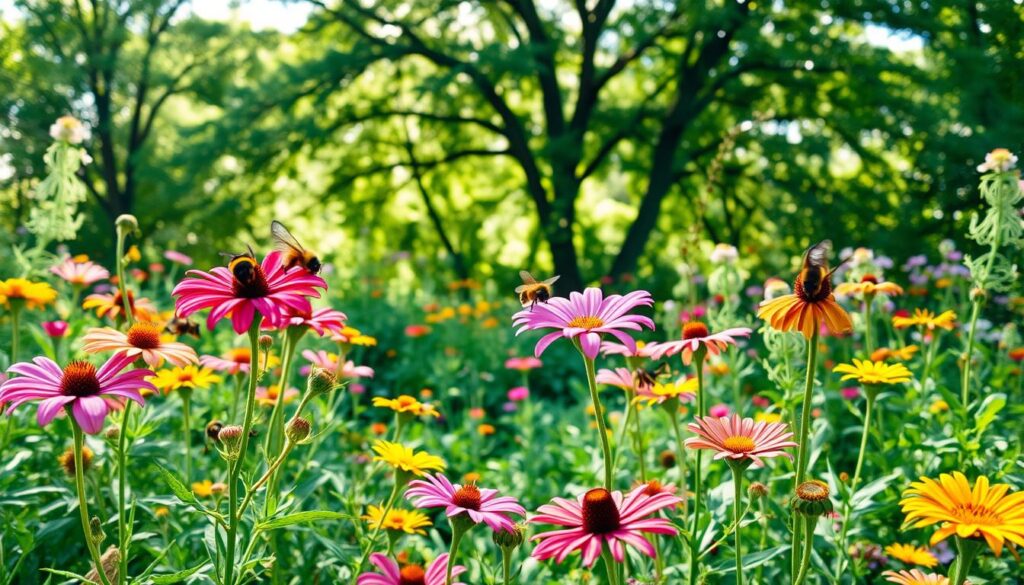
Attracting Beneficial Insects
Flowering plants like zinnias, borage, and sunflowers are magnets for pollinators. These flowers attract bees, butterflies, and other beneficial insects that help control pests naturally. For example, ladybugs feast on aphids, reducing the need for chemical treatments.
Integrated pest management (IPM) is a sustainable approach that relies on beneficial insects. By planting pollinator-friendly species, you create a balanced ecosystem where pests are kept in check naturally. This method is especially effective for organic gardening.
Enhancing Garden Productivity
Pollinators play a crucial role in increasing yields. Bees and butterflies ensure that your vegetables and fruit are well-pollinated, leading to better harvests. To maximize their impact, design a border with a continuous bloom calendar. This ensures that pollinators have food sources throughout the growing season.
Native plants are another excellent choice. They are adapted to your region’s climate and provide essential resources for local pollinators. For example, milkweed is vital for monarch butterflies. By including these species, you can even certify your space as a monarch butterfly waystation.
- Top pollinator magnets: zinnias, borage, sunflowers.
- Integrated pest management reduces the need for chemicals.
- Design borders with a continuous bloom calendar.
- Include native plants for regional adaptability.
- Certify your space as a monarch butterfly waystation.
For more tips on creating a pollinator-friendly space, check out this guide on gardening for beginners. It’s a great resource for building a thriving outdoor area that supports both plants and pollinators.
Rotating Crops for Soil Health
Rotating crops is a simple yet effective way to keep your soil healthy and productive. By changing what you plant in each area every season, you can prevent diseases, reduce pests, and maintain nutrient-rich soil. This practice ensures your plants thrive year after year.

Preventing Diseases and Pests
Crop rotation disrupts the life cycles of pests and diseases. For example, planting tomatoes in the same spot every year can lead to tomato blight. A 3-year rotation cycle helps break this cycle, keeping your garden healthier.
Here’s a simple 4-bed rotation chart to follow:
| Bed | Year 1 | Year 2 | Year 3 |
|---|---|---|---|
| Bed 1 | Tomatoes | Beans | Lettuce |
| Bed 2 | Carrots | Tomatoes | Beans |
| Bed 3 | Lettuce | Carrots | Tomatoes |
| Bed 4 | Beans | Lettuce | Carrots |
Maintaining Nutrient-Rich Soil
Different plants have unique nutrient needs. Heavy feeders like tomatoes deplete nitrogen, while nitrogen givers like beans replenish it. Rotating these vegetables ensures balanced soil fertility.
Cover cropping between seasons is another great strategy. Plants like clover or rye add organic matter and nutrients back into the soil. This keeps your beds ready for the next planting cycle.
- Test your soil regularly with a simple kit to monitor nutrient levels.
- Use cover crops to improve soil structure and fertility.
- Rotate heavy feeders with nitrogen givers for balanced growth.
Using Soil Amendments for Better Growth
Healthy soil is the foundation of a thriving outdoor space. The right mix of nutrients and organic matter ensures your plants grow strong and produce bountiful harvests. Whether you’re working with a raised bed or traditional planting areas, soil amendments can make a significant difference.
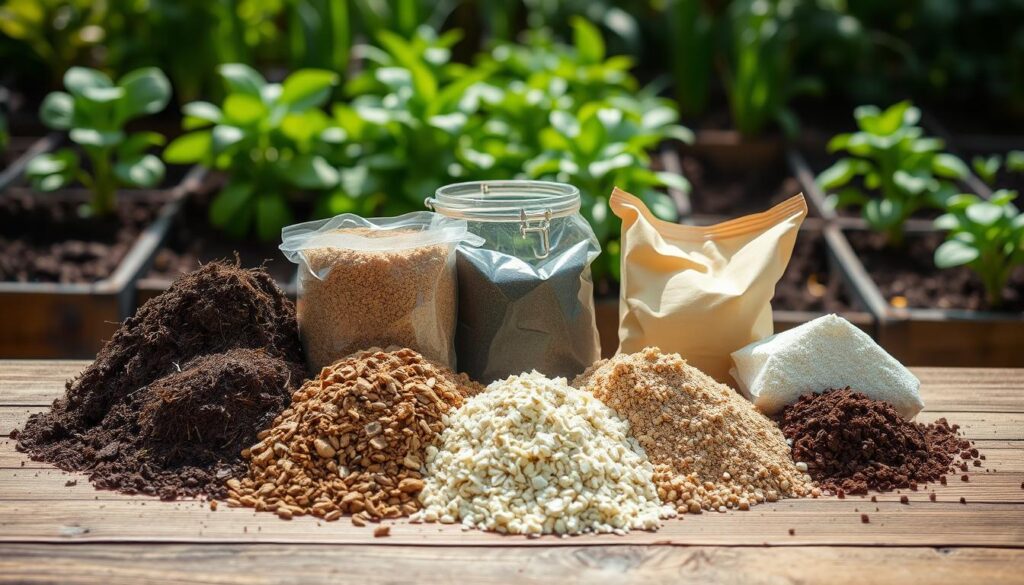
Selecting the Right Soil Mix
Choosing the perfect soil blend depends on what you’re growing. For vegetables, a mix of compost, peat moss, and vermiculite works well. Compost enriches the soil with organic matter, while peat moss improves moisture retention. Vermiculite ensures proper drainage, preventing waterlogged roots.
Worm castings are another excellent option. They provide slow-release nutrients and improve soil structure. Compared to compost, worm castings are richer in beneficial microbes, making them ideal for nutrient-hungry plants like tomatoes and peppers.
Feeding Your Plants Regularly
Regular feeding keeps your plants healthy and productive. Products like Miracle-Gro® offer balanced nutrition, ensuring your garden gets the essential nutrients it needs. Understanding NPK ratios (nitrogen, phosphorus, potassium) is key. For example, nitrogen promotes leafy growth, while phosphorus supports root development.
Over-fertilization can harm your plants, leading to burned roots or stunted growth. Stick to a seasonal feeding schedule to avoid these issues. In spring, focus on nitrogen-rich fertilizers for vigorous growth. In summer, switch to balanced formulas to support flowering and fruiting.
- Compare compost and worm castings for nutrient benefits.
- Create custom soil blends tailored to your plants.
- Understand NPK ratios and recognize deficiency symptoms.
- Follow a seasonal feeding schedule for continuous harvests.
- Avoid over-fertilization to prevent damage.
Learning from Your Garden’s Successes and Failures
Every season offers lessons to refine your gardening approach. Whether you’re growing tomatoes or herbs, reflecting on what worked—and what didn’t—helps you improve. Documenting your journey ensures better results in the future.

Keeping a Garden Journal
A garden journal is a powerful tool for tracking progress. Whether you prefer digital apps or handwritten notes, recording details like planting dates, weather conditions, and challenges helps you spot patterns. For example, noting which tomato varieties thrived can guide your plans for next year.
Digital tools like spreadsheets make it easy to track harvests and analyze data. Analog journals, on the other hand, offer a personal touch and can include sketches or photos. Choose the method that suits your style and time availability.
Making Adjustments for Future Seasons
Analyzing your journal helps you make informed adjustments. Did certain plants struggle in a specific spot? Was watering consistent? These insights allow you to tweak your layout and practices for better results.
End-of-season evaluations are especially valuable. Create a checklist to review what worked, what didn’t, and what you’d like to try next year. For example, if pests were an issue, consider companion planting or natural remedies.
- Compare digital vs. analog journaling methods for tracking progress.
- Use a harvest tracking spreadsheet to monitor yields over time.
- Identify common first-year mistakes and how to avoid them.
- Take photos to compare growth and changes season to season.
- Complete an end-of-season evaluation checklist for actionable insights.
“A garden journal is more than a record—it’s a roadmap to success.”
Inspiration from Real Garden Layouts
Drawing inspiration from real-life designs can spark creativity for your outdoor space. Seeing how others have transformed their areas provides fresh ideas and practical insights. Whether you’re working with a small space or a larger area, these examples can guide your planning process.
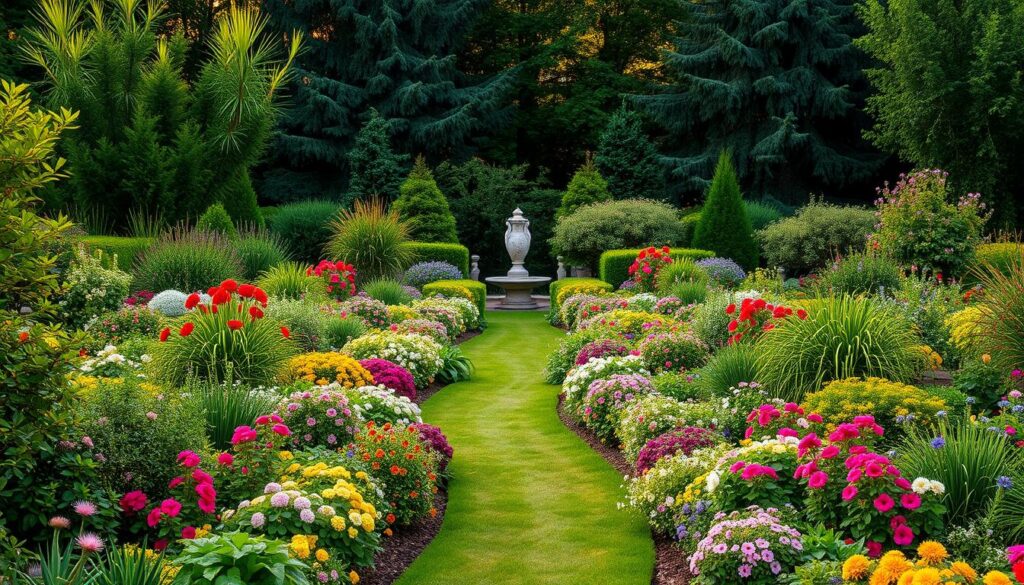
Exploring Square-Foot Gardening
Square-foot gardening (SFG) is a popular method for maximizing yields in limited areas. By dividing a raised bed into 1-foot squares, you can grow a variety of vegetables efficiently. Compared to traditional row planting, SFG often produces higher yields with less effort.
For example, an urban balcony transformation case study showed how SFG turned a tiny space into a productive kitchen garden. The setup included herbs, lettuce, and cherry tomatoes, all thriving in a compact area. This method is perfect for those with limited room but big gardening dreams.
Viewing Backyard and Raised Bed Examples
Backyard designs and raised bed setups offer endless possibilities. One successful homestead garden featured a mix of vegetable garden layouts, including drought-resistant plants like peppers and zucchini. The use of raised beds ensured proper drainage and easy access for maintenance.
Another example showcased a family’s backyard transformation, where they combined flowers and vegetables for a visually appealing and functional space. These real-world designs prove that with a little creativity, any area can become a thriving oasis.
- Compare SFG vs traditional row yields for efficiency.
- Analyze successful homestead garden dimensions for inspiration.
- Include drought-resistant layout examples for sustainability.
- Explore urban balcony transformations for small space solutions.
- Use garden planning software to visualize your ideas.
Conclusion
Every gardening journey is unique, offering lessons and rewards with each season. By applying key planning principles, you can create a thriving space for your plants and enjoy a bountiful harvest. Start small and expand gradually to build confidence and avoid overwhelm.
Local extension offices are a valuable resource for tailored advice and support. They can help you choose the right vegetables for your area and provide tips for success. Connecting with community gardening groups is another great way to share knowledge and inspiration.
Remember, your garden is a reflection of your effort and creativity. Celebrate your successes, learn from challenges, and keep improving. With dedication and passion, you can transform your outdoor space into a thriving oasis. Start today and enjoy the journey!

